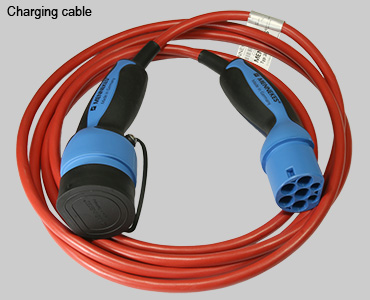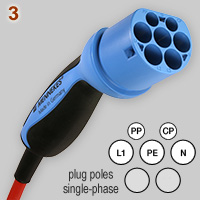 |
IEC 62196 plugs for electric vehicles |
| IEC 62196 is a series of standards
that
define requirements and tests for outlets, plugs,
connectors and inlets for recharging batteries of electric vehicles
(EV). The first version was published in 2011. IEC 62196-1: general requirements. IEC 62196-2: dimensional compatibility and interchangeability requirement for AC charging. IEC 62196-3: DC and combined AC/DC charging. Worldwide the following three systems ('types') have been standandized in IEC 62196-2. IEC 62196 Type 1 relates to the design of the Japanese manufacturer Yazaki. The charging configuration only supports single phase up to 32A. It is widely used in the US and Japan. |
 |
IEC 62196 Type 2 relates to
the design of the German manufacturer Mennekes. It covers
both single
and three-phase charging. 230V single-phase up to 32A, and 400V
three-phase up to 63A. The single plug geometry can be used for single
and three-phase AC charging. Type 2 has been adopted by the European Parliament as EU standard in April 2014. Plug and connector shown below are examples of Mennekes Type 2 material. IEC 62196 Type 3 relates to the design of the Italian manufacturer Scame. The company, in conjunction with Legrand and Schneider Electric, has developed several types of plug geometries for single, two and three-phase charging. Outlets and connectors are protected by safety shutters. Type 3 is mainly used in France and Italy. |
 Mode 3 charging station complies with IEC 16851: the EV supply Equipment provides residual current protection and overcurrent shutdown. Type 2 vehicle inlet (not shown), charging cable (image right) and charging station outlet (image 5) comply with IEC 62196-2. See MENNEKES site for detailed information and other charging modes. Mode 3 is the standard charging mode in Europe. |
 |
 |
 |
 |
 |
| ↓ |
 |
 |
 |
 |
| 1,
2 |
IEC
62196 Type 2 connector of charging cable, shown top right. The Mennekes
single phase model 36110 is rated at 20A - 230V. The model for Mode 3
charging stations was introduced in 2012. The external geometry of
connector and plug (image nos 3 and 4) is identical for single and
three phase. The only visible difference is the absence / presence of
L2 and L3 pins and sleeves. A single phase cable can he used with a
three-phase Mode 3 charging station (see image no. 5). {HA} |
| 3,
4 |
IEC
62196 Type 2 single phase plug. The PP and CP contacts of Mode 3
charging cables monitor and control the charging process. PP =
proximity or plug present contact. It signals the presence of cable
contact, a prerequisite for starting the charging procedure by the
station. Moreover, as long as the cable is attached to the vehicle it
is not possible to start the car engine. CP = control pilot. Using PWM (pulse width modulation) technique the EVSE (Electric Vehicle Supply Equipment) of the charging station regulates the current, that varies during the charging process. Moreover, several protection features are monitored. PE = protective earth connection. |
| 5 | IEC
62196 Type 2 outlet of the Mode 3 charging station shown at the top of
page. Rating: 400V 3-phase, 11kW. The image of an EVBOX has been taken
at a Dutch public parking area. Manufacturer of the outlet and
connected electronics is unknown. Type 2 has a single plug / connector geometry that can be used for both single and three-phase charging. The maximum charging current may vary, depending on the capacity of charging station. The exterior of charging cables is identical; only the electronics inside differ. Type 2 connection cannot be used DC high (max. 170 kW) charging. |
| notes |
Manufacturer of charging cable: Mennekes Stecker GmbH & Co. KG in Kirchhundem (Westfalen, Germany), a subsidiary of the Mennekes-group. The company has developed charging devices for electric vehicles that became the IEC 62196 Type 2 standard. From 2016 Mennekes offers charging stations and cables with safety shutters that are compulsory in France and Italy. The museum is grateful to HATEHA for donating the charging cable. HATEHA is the Dutch agent of Mennekes and other manufacturers of electro-technical material. The company, founded in 1966, is based in Hazerswoude-Rijndijk, Netherlands. |
| |
D i g i t a l M u s e u m o f | |
P l u g s a n d S o c k e t s | |